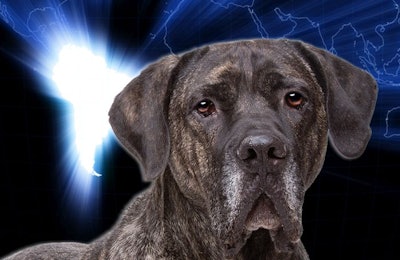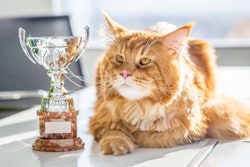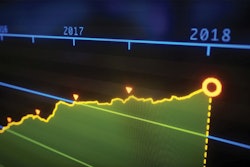
Latin America’s pet food market possibilities are a mixed bag of late-stage developing market numbers, but has significant future potential as pet ownership and disposable income both become more prevalent in the region. With a 6 percent compound annual growth rate (CAGR) for the pet food market between 2011 and 2016, according to a Euromonitor International global trends report presented at Global Pet Expo 2017, Latin America comes out on top in terms of developing regions to keep an eye on. In fact, according to Euromonitor, the area has the highest CAGR of all regions (Middle East/Africa comes in second, at 5 percent) when it comes to pet food, and the second-highest CAGR (7 percent, topped only by Australasia’s 8 percent) for other pet products between 2011–2016 (see Figure 1).
The obvious answer to this growth is that something else is growing, too: Latin America’s middle class. In 2006, the percentage of Mexico households with disposable income above US$25,000 sat at roughly 55 percent, according to Euromonitor. By 2016, that number had grown to roughly 63 percent. Brazil, Argentina, Chile, Venezuela — each of these countries had less than 50 percent of their households reporting disposable income above US$25,000 in 2006, but today at least half (and mostly more than half) of their households have extra money to spend.
The potential of pet owners in Latin America
Evidence from more developed markets, such as North America, would imply that those households want to spend at least some of that extra money on their pets. But while North America spent US$131 per capita on pet care sales in 2016, Latin America spent only US$16 per capita. So, where are the opportunities?
“Growing middle classes, the spread of certain diseases associated with dogs and cats as well as rapid urbanization are fueling the massive increase in size in both value and volume of the pet food market in Latin America,” said Euromonitor in its April 2017 “Pet food in Latin America” report. The spread of diseases has served to educate pet owners on the importance of pet nutrition, leading to an increase in the demand for prescription diets and more premium pet foods. And as pets are mainly kept by individuals and families living in urban areas, “rapid urbanization in Latin America due to migration from poorer rural areas is very good news for the pet food industry across the continent,” said Euromonitor.
Brazil is the third-largest pet food market in the world after the US and China, according to Euromonitor data, and future growth projections indicate that Brazil is forecast to maintain its position among the top 10 biggest markets through at least 2021. Mexico also ranks highly and is not far behind, but slightly more than two-thirds of all pet food sold in Latin America is sold in Brazil.
But Latin America is also a study in sharp contrasts when it comes to the pet food market. “There is an enormous difference in the volume of pet food being sold in the major economies of the region such as Brazil, Mexico and Argentina in comparison to the smaller ones such as Uruguay, the Dominican Republic and Bolivia,” said Euromonitor. “The market in these countries is negligible and is remaining fairly constant.”
Spotlight: Top pet food companies in Latin America
- Revenue (2016): US$181,876,537
- Pet food markets served: Latin America, Asia Pacific, Eastern Europe, North America
- Brands: Equilíbrio Veterinary, Equilíbrio, Max, Max Cat, Naturalis, K&S, Lider, Nero, Doglicious, Catlicious
Brazil-based Total Alimentos (a subsidiary of France-based Neovia) is currently focusing on new product lines and overall innovation to expand its presence in the international pet food markets as well as domestically.
In February 2017, the company relaunched its Max premium pet food brand, revamping the packaging “with a more modern look” and introducing two new dog food lines, Max Professional (free of dyes and artificial flavorings) and Max Soft Croc (featuring high palatability and both soft and crispy textures), according to Total Alimentos. The relaunch also marked the company’s entry into the moist dog and cat food segment, bringing pâtés into the Total Food portfolio.
In March 2017, Total Alimentos participated in two shows in China in order to expand its presence in that country. “The company's participation in these events was mainly focused on the promotion of the superpremium Equilíbrio and newly relaunched premium Max brands,” said Cláudio Dafferner, manager of Total Alimentos' international business. “The events were directed to manufacturers of dog and cat food, and places Total Alimentos as a benchmark in quality and efficient and safe production processes.”
The Equilíbrio line includes a recently added grain-free line boasting a 95 percent high animal protein biological value and specialized carbohydrate sources such as cassava, according to the company.
In July 2017, Total Alimentos released its Pet To Go vending machines, designed to meet the demand for fast purchases by pet owners looking for convenience in their pet food purchasing. The machines carry the Balance product line, Doglicious and Catlicious snack lines, and Max pâtés. The company partnered with the pet-friendly Galleria Shopping Mall in Campinas, Brazil, in July 2017 and pet-friendly Shopping Prado Boulevard, also in Campinas, in August 2017.
“Installed in the elevator hall, the machine has an interactive system in which the customer selects which pet they own and if they want to buy food or snacks,” said Total Alimentos. "The products have compact sizes, precisely to bring ease to the customer who wants to take home or please their pet right there on the spot.”
Also in August 2017, Total Foods exhibited at Pet Seoul 2017, a show held in South Korea and directed at the Korean specialized market, including shopkeepers, pet shops and veterinarians. “Participation in this fair presented and strengthened the presence of our company in the Korean market, which is a new space that we are seeking to enhance our presence in via exports, as well as throughout Asia," said Dafferner.
- Revenue (2016): US$158,200,000
- Pet food markets served: Latin America, Asia Pacific, North America
- Brands: Master Cat, Master Dog, Mimaskot, Nutrican
Chile-based Empresas Carozzi first entered the pet food market with its acquisition of Nutripro in 2011, and has focused on expansion ever since; 2017 was no different.
In September 2017, the company opened a pet food plant in Peru, investing US$24 million in expanding its production capacity in response to its growing influence in Peru and other Latin American countries. “Our dream of going further became reality with the purchase of Mimaskot and Nutrican at the end of 2013,” said Gonzalo Bofill Velarde, president of Empresas Carozzi. “In these two great brands, very well positioned in the Peruvian market, we found an opportunity to undertake a category that empowered us and incorporated us into markets with great expectations of growth.”
Empresas Carozzi has also taken up the cause of sustainability, touching on a trend affecting all the developed pet food markets. “We are committed to providing the best standards in all our products,” said the company on its website. “To achieve this, we have a Quality and Food Security Policy that covers all our plants and branches of the Chile, Peru and Agrozzi divisions.” The company has also focused on halal and kosher certifications, ensuring its ability to export to Middle East pet food markets.
Finally, as with other companies trying to make a connection with their customers in this day and age, Empresas Carozzi focused on consumer education in 2017. The company conducted tours for children through its pasta, cereals and cookies plants. The tours, which focused on food processing, aimed at educating consumers on nutrition and health.
The company also implemented “Plan AM,” a strategy promoting food and movement for a more balanced and healthier life. The plan has three components directed at students studying health and education, teachers and parents, and children.
- Revenue (2016): US$152,645,000
- Pet food markets served: Latin America, Asia Pacific, Eastern Europe, Western Europe
- Brands: Guabi Natural, Heroi, TopCat, Cat Meal, Limpi Cat, GranPlus, Sabor & Vida, Faro, Biriba, Fiel
Brazil-based Mogiana Alimentos SA, operating as Guabi, has used its partnerships to expand its pet food presence.
Mogiana operates a joint venture with the Spanish firm Affinity Petcare (Agrolimen Group, Spain), which purchased a 50 percent stake in Mogiana in 2013, commencing a joint venture to operate Mogiana's two manufacturing plants in Campinas and Bastos, both in Sao Paolo, Brazil.
Mogiana has five primary brands: Ultima, GranPlus and Faro (Affinity brands), Natural (a Guabi brand) and Sabor & Vida. Each brand focuses on various aspects of the premium and superpremium pet food markets, including Ultima’s focus on high-quality nutrition; GranPlus’ formulas made for intestinal health, high palatability and shiny coats; Faro’s premium focus on breed-specific formulas; Natural’s ProtectLife system (combining antioxidants, vitamins, high-quality proteins and plyphenols); and Sabor & Vida’s lifestage-specific formulas.
More on Latin America’s top pet food companies


















